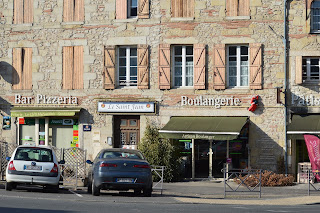The morning sun is streaming in through the long windows of the marketplace. Sellers are standing at long trellis tables, their charcoal-coloured nuggets laid out neatly on little white doilies. Beside each truffle is written its weight and price.
As 10 o'clock approaches, the anticipation mounts. The white-moustached man who spoke to us on arrival, re-appears as Doctor Who ... in a flowing black gown, wearing a black fedora and sporting a double gold sash around his neck. He has assumed the role as patron of truffles, the master of ceremonies.
The church bell chimes from on high. This is the signal for a man in a blue rain jacket and scarf to look up at the expectant crowd and shake a small, silver bell, announcing the start of the Prayssas truffle market.
The rope drops, buyers surge forward to engage with sellers, truffles are picked up and sniffed, money changes hands. Within ten minutes, it is pretty much all over.
 |
| Truffle sellers with their treasures on display |
 |
| Buyers ready to go |
 |
| The truffle "Master" |
 |
| With an earthy or yeasty nose, these gourmet fungi are worth 1000 euros a kilo |
 |
| Black gold |
Truffles are venerated by gourmands all over the world and their production has spread as far a field as Australia.
French producers now use dogs more than pigs to uncover the treasure.
Its near mythical status means the ceremonial protocols surrounding its sale have assumed almost religious proportions.



























